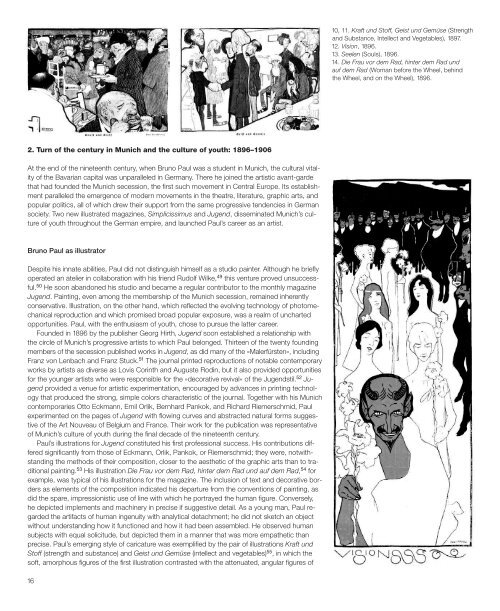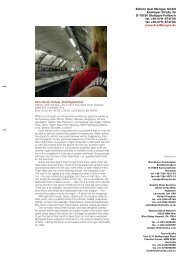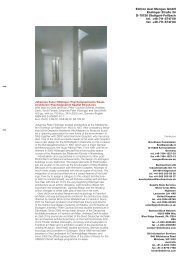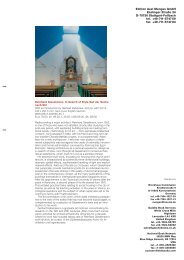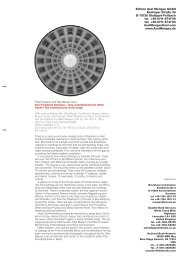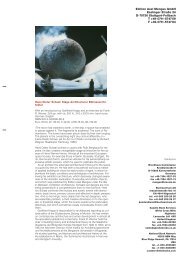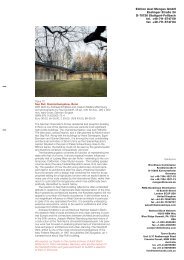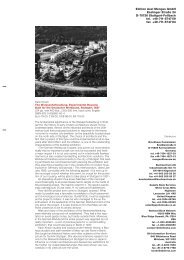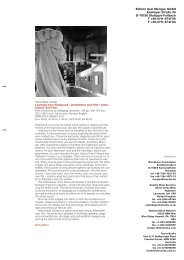Bruno Paul - Edition Axel Menges
Bruno Paul - Edition Axel Menges
Bruno Paul - Edition Axel Menges
Create successful ePaper yourself
Turn your PDF publications into a flip-book with our unique Google optimized e-Paper software.
2. Turn of the century in Munich and the culture of youth: 1896–1906<br />
At the end of the nineteenth century, when <strong>Bruno</strong> <strong>Paul</strong> was a student in Munich, the cultural vitality<br />
of the Bavarian capital was unparalleled in Germany. There he joined the artistic avant-garde<br />
that had founded the Munich secession, the first such movement in Central Europe. Its establishment<br />
paralleled the emergence of modern movements in the theatre, literature, graphic arts, and<br />
popular politics, all of which drew their support from the same progressive tendencies in German<br />
society. Two new illustrated magazines, Simplicissimus and Jugend, disseminated Munich’s culture<br />
of youth throughout the German empire, and launched <strong>Paul</strong>’s career as an artist.<br />
<strong>Bruno</strong> <strong>Paul</strong> as illustrator<br />
Despite his innate abilities, <strong>Paul</strong> did not distinguish himself as a studio painter. Although he briefly<br />
operated an atelier in collaboration with his friend Rudolf Wilke, 49 this venture proved unsuccessful.<br />
50 He soon abandoned his studio and became a regular contributor to the monthly magazine<br />
Jugend. Painting, even among the membership of the Munich secession, remained inherently<br />
conservative. Illustration, on the other hand, which reflected the evolving technology of photomechanical<br />
reproduction and which promised broad popular exposure, was a realm of uncharted<br />
opportunities. <strong>Paul</strong>, with the enthusiasm of youth, chose to pursue the latter career.<br />
Founded in 1896 by the publisher Georg Hirth, Jugend soon established a relationship with<br />
the circle of Munich’s progressive artists to which <strong>Paul</strong> belonged. Thirteen of the twenty founding<br />
members of the secession published works in Jugend, as did many of the »Malerfürsten«, including<br />
Franz von Lenbach and Franz Stuck. 51 The journal printed reproductions of notable contemporary<br />
works by artists as diverse as Lovis Corinth and Auguste Rodin, but it also provided opportunities<br />
for the younger artists who were responsible for the »decorative revival« of the Jugendstil. 52 Jugend<br />
provided a venue for artistic experimentation, encouraged by advances in printing technology<br />
that produced the strong, simple colors characteristic of the journal. Together with his Munich<br />
contemporaries Otto Eckmann, Emil Orlik, Bernhard Pankok, and Richard Riemerschmid, <strong>Paul</strong><br />
experimented on the pages of Jugend with flowing curves and abstracted natural forms suggestive<br />
of the Art Nouveau of Belgium and France. Their work for the publication was representative<br />
of Munich’s culture of youth during the final decade of the nineteenth century.<br />
<strong>Paul</strong>’s illustrations for Jugend constituted his first professional success. His contributions differed<br />
significantly from those of Eckmann, Orlik, Pankok, or Riemerschmid; they were, notwithstanding<br />
the methods of their composition, closer to the aesthetic of the graphic arts than to traditional<br />
painting. 53 His illustration Die Frau vor dem Rad, hinter dem Rad und auf dem Rad, 54 for<br />
example, was typical of his illustrations for the magazine. The inclusion of text and decorative borders<br />
as elements of the composition indicated his departure from the conventions of painting, as<br />
did the spare, impressionistic use of line with which he portrayed the human figure. Conversely,<br />
he depicted implements and machinery in precise if suggestive detail. As a young man, <strong>Paul</strong> regarded<br />
the artifacts of human ingenuity with analytical detachment; he did not sketch an object<br />
without understanding how it functioned and how it had been assembled. He observed human<br />
subjects with equal solicitude, but depicted them in a manner that was more empathetic than<br />
precise. <strong>Paul</strong>’s emerging style of caricature was exemplified by the pair of illustrations Kraft und<br />
Stoff (strength and substance) and Geist und Gemüse (intellect and vegetables) 55 , in which the<br />
soft, amorphous figures of the first illustration contrasted with the attenuated, angular figures of<br />
10, 11. Kraft und Stoff, Geist und Gemüse (Strength<br />
and Substance, Intellect and Vegetables), 1897.<br />
12. Vision, 1896.<br />
13. Seelen (Souls), 1896.<br />
14. Die Frau vor dem Rad, hinter dem Rad und<br />
auf dem Rad (Woman before the Wheel, behind<br />
the Wheel, and on the Wheel), 1896.<br />
the second. The visual analogy was no less effective for its simplicity, a quality ideally suited to<br />
the medium of its reproduction.<br />
Notwithstanding his explorations of the conventions of printed art, <strong>Paul</strong> never renounced his<br />
academic training as a painter. His illustrations for Jugend reflected his continuing admiration for<br />
Franz Stuck. His compositions Adam u. Eva (Adam and Eve), 56 Vision (vision), 57 and Der Sündenfall<br />
(the fall of man) 58 were all variations on the symbolism of Stuck’s notorious Die Sünde (the<br />
sin). Moreover, <strong>Paul</strong> often adopted specific details from Stuck’s paintings. The suggestive Lilly of<br />
Stuck’s Innocentia (innocence) of 1889, for example, reappeared in <strong>Paul</strong>’s drawing Vision, just as<br />
the knotted serpents of Stuck’s Medusa of 1892 appeared as a decorative border for Adam u.<br />
Eva. In addition, many of <strong>Paul</strong>’s captions employed the antique letter forms that Stuck preferred,<br />
such as his illustration for Victor Hardung’s poem Seelen (souls). 59 <strong>Paul</strong>’s Seelen was a perfect<br />
expression of the interrelationship of the Jugendstil and the broader Symbolist movement, particularly<br />
as embraced by Stuck. Yet <strong>Paul</strong> transformed the portentous biblical and mythological<br />
themes beloved of the Symbolists into a critique of contemporary society as he developed his<br />
own personal style. In so doing, he produced a series of commentaries that were both sharper<br />
and more satiric than the majority of illustrations in Jugend. They were, in fact, closer to the spirit<br />
of the Munich weekly Simplicissimus, the magazine that would make <strong>Paul</strong>’s reputation as an<br />
artist.<br />
Simplicissimus<br />
In the spring of 1897, <strong>Paul</strong> accepted a position as an illustrator for Simplicissimus. Albert Langen,<br />
a Munich publisher, had established the weekly magazine the previous year in conjunction with the<br />
secession painter Thomas Theodor Heine. 60 They conceived Simplicissimus as an erudite literary<br />
journal, and the first issues contained songs and poems as well as prose contributions by prominent<br />
authors including the young Thomas Mann and the playwright Frank Wedekind. Although its<br />
format was similar to that of Jugend, Simplicissimus distinguished itself through its biting social<br />
and political satire. Indeed, Langen soon abandoned his original ambitions for Simplicissimus,<br />
and printed a magazine wholly devoted to sarcastic commentary on both the German government<br />
and popular morality. 61 This boldness prompted the Bavarian government to ban an 1898<br />
issue of Simplicissimus satirizing a pilgrimage to the Holy Land undertaken by Kaiser Wilhelm II,<br />
and to condemn Heine and Wedekind to six months imprisonment in the fortress of Königstein<br />
for insulting the emperor, the crime of lèse majesté. Langen himself fled Munich to spend five<br />
years in Paris as a political exile. Governmental censure, however, only provoked popular support<br />
for the magazine and confirmed its reputation as the embodiment of the bold and irreverent spirit<br />
of Munich’s cultural avant-garde. This spirit had already begun to manifest itself in the March of<br />
1897, when <strong>Paul</strong>’s first full-page illustration, Entwurf zu einem Denkmal für den Deutschen Michel<br />
(project for a monument to the average German), appeared in Simplicissimus. 62<br />
When <strong>Paul</strong> joined Simplicissimus, the members of the staff were retained as salaried employees.<br />
His acceptance of such a paid position was yet one step further removed from his father’s<br />
ambition that he should become a clergyman or a teacher. But Gustav <strong>Paul</strong> died on 28 February<br />
1897 at the age of sixty-one, freeing <strong>Bruno</strong> from the burden of paternal expectation. Joining the<br />
staff of Simplicissimus was a clear assertion of his independence, a final renunciation of his early,<br />
half-hearted efforts to enter one of the traditional learned professions.<br />
As an employee of Simplicissimus, <strong>Paul</strong> published more than four hundred illustrations over<br />
nine years, in a style unlike that employed by any of the other artists on the staff. His early illustration<br />
Entwurf zu einem Denkmal für den Deutschen Michel demonstrated the lingering influence of<br />
Stuck and the traditions of academic art in the form of the antique altar that formed the base of<br />
the proposed monument as well as the classicizing form of his signature: BR. PAVL. However his<br />
devotion to such precedents was soon supplanted by his own emerging, idiosyncratic style, already<br />
apparent in his illustration Vis-à-vis, published in March 1897. 63<br />
<strong>Paul</strong>’s graphic vocabulary was related directly to the manner in which he composed, using<br />
India ink, pencil, charcoal and watercolor. Although he utilized a variety of media, his illustrations<br />
reflected his training as a painter. As he refined his skills, <strong>Paul</strong> relied less frequently upon pencil<br />
underdrawings for his illustrations, instead composing directly with a brush. His originals were significantly<br />
larger than the printed versions in Simplicissimus; at an average size of 30 x 40 cm, they<br />
were painterly in scale as well as technique. 64 One of the few surviving paintings by <strong>Paul</strong>, a 1900<br />
composition entitled Alles eine Nummer zu groß! (everything one size too large!), demonstrated<br />
16 17


